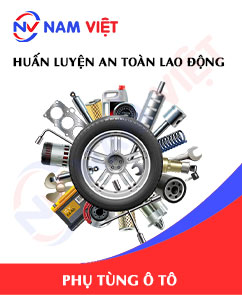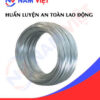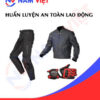Occupational Safety Training For Auto Parts Manufacturing
99,000 ₫
Note: The above price is calculated for one person, the price may fluctuate depending on the number of trainees participating in the course and the movement of the market. For more accurate pricing support, please refer to the quotation or contact directly with our consultants.
Occupational safety is an important issue in auto parts manufacturing factories and needs to be addressed promptly to ensure the health and safety of workers, as well as to enhance the reputation of enterprises. The Occupational Safety Training course is one of the effective solutions to raise awareness about preventing occupational accidents for workers participating in auto parts manufacturing.
Table of Contents
Toggle1. Overview of Auto Parts
a. What are Auto Parts?
- Auto parts are components and accessories used to repair, maintain, and upgrade cars. These parts may include mechanical components such as engines, gearboxes, suspension systems, braking systems, steering systems, and interior, exterior, electronic parts such as lights, sensors, air conditioning, entertainment systems, and more.
- Auto parts are typically manufactured by professional auto parts manufacturers and supplied to car dealerships and repair shops to meet customers’ maintenance and repair needs.

b. Types of Machinery for Auto Parts Manufacturing
There are many types of machinery used in auto parts manufacturing, including:
- CNC Milling Machines: used to process metal components such as wheel rims, engines, and other parts.
- CNC Lathes: used to manufacture metal components in cylindrical, disc, pipe shapes, and other parts.
- Laser Cutting Machines: used to cut metal, plastic, and other materials to create precise and complex components.
- Plastic Injection Molding Machines: used to produce plastic parts such as door handles, interior parts, and other components.
- Casting Machines: used to cast metal parts such as brake discs, exhausts, and other components.
- Dynamic Balancing Machines: used to balance car wheels.
- Vibration Testing Machines: used to test the vibration of car components such as engines, gearboxes, and other parts.
- Press Molding Machines: used to produce large and complex metal components.
These machines play a crucial role in auto parts manufacturing, helping produce precise components that meet technical requirements.

c. Auto Parts Manufacturing Companies in Vietnam
There are many famous auto parts brands worldwide. Some popular brands include:
- Bosch: Bosch is one of the most famous auto parts brands. The company provides products from filters to braking systems, engines, and electronic components.
- Continental: Continental is a leading global auto parts manufacturer. The company provides products such as tires, braking systems, engines, air conditioning systems, and electronic components.
- Denso: Denso is a well-known Japanese auto parts brand. The company provides products from electrical systems, engines to braking systems and exhaust systems.
- Delphi Technologies: Delphi Technologies is a UK-based auto parts manufacturer. The company provides products from filters to fuel and engine systems.
- Valeo: Valeo is one of the leading auto parts manufacturers in the world, headquartered in France. The company provides products such as steering systems, braking systems, air conditioning systems, and electronic components.
- Magneti Marelli: Magneti Marelli is an Italian auto parts manufacturer. The company provides products such as headlights, engine control systems, electrical systems, and electronic components.
- TRW Automotive: TRW Automotive is a US-based auto parts manufacturer. The company provides products such as braking systems, steering systems, exhaust systems, and safety systems.
- ACDelco: ACDelco is a well-known American auto parts brand. The company provides products such as filters, engines, electrical systems, and braking systems.

d. Specific Jobs in an Auto Parts Manufacturing Factory
Group 1
- Executive directors, deputy directors, department heads in an auto parts manufacturing factory.
Group 2
- Safety Officers: manage safety in the factory, design safety procedures, supervise and ensure employees comply with safe working processes.
Group 3
- Manufacturing: The auto parts factory is equipped with specialized machines to produce components such as engines, gearboxes, chassis, and wheels. Workers operate machines to cut, grind, cast, and shape parts to create precise auto parts that meet technical requirements.
- Quality Control: Auto parts are inspected to ensure they meet technical and safety standards. Quality control includes checking precision, load capacity, and durability of parts.
- Packing and Transport: After quality inspection, parts are packed and transported to car manufacturers or distribution dealers for assembly.
- Maintenance and Repair: Auto parts manufacturers also provide maintenance and repair services. Technicians are trained to repair and maintain auto parts for optimal performance and safety.
Group 4
- Office, service, sales, and marketing jobs.
- Production management, quality management, human resources management, material management, financial and accounting management.
- Design: Auto parts design engineers research and develop new products, using CAD/CAM software to create 3D models and simulate them to ensure they meet technical and safety standards.

e. Popular Auto Parts on the Market
There are many types of auto parts in the market, depending on the car brand and model. Some of the most common auto parts include:
- Oil filters, air filters, fuel filters: essential parts in the car engine system, filtering dust and debris to protect the engine.
- Battery: supplies energy to the car’s electrical system, helps start the engine, and maintain electrical devices.
- Air Intake Filters: filters air before entering the engine for smooth and durable engine operation.
- Shock Absorbers: reduce impact from bumpy roads, increasing comfort and safety during travel.
- Brakes: crucial in the braking system, helping slow down and stop the car safely.
- Bearings: support other components’ operation, reduce friction, and improve durability.
- Brake Pads: ensure braking performance and safe control of the car.
- Engine Control Units: control engine operations for stable and durable performance.
- Tires: essential for movement, improving grip and reducing wear on other parts.
- Suspension Systems: support steering operation and absorb shocks from road irregularities.
2. Overview of Occupational Safety Training for Auto Parts Manufacturing
This article focuses on Group 3 because Group 3 is directly involved in manufacturing and faces the highest occupational safety risk. For other groups, refer here.
a. What is Group 3 Occupational Safety Training?
- Occupational safety training for Group 3 consists of sessions to equip workers with awareness and skills to prevent workplace accidents.
- The training helps workers identify hazards and risks, reducing the likelihood of workplace accidents during operations.
REGISTER FOR OCCUPATIONAL SAFETY TRAINING SERVICE
b. Training Duration
Initial Safety Training Duration
- Total training duration is at least 24 hours, including examination time.
- 8 hours of theory on occupational safety and hygiene policies and laws
- 8 hours of theory on basic knowledge of occupational safety and hygiene
- 4 hours of theory on specialized training content
- 2 hours of practice on specialized training content
- 2 hours of final theoretical examination
The safety training center will schedule sessions depending on worker availability. Typically, there are 6 sessions over 3 days, provided the company can arrange continuous training.
Periodic Safety Training Duration
- Before the occupational safety card expires, employees wishing to renew must undergo periodic occupational safety training, with periodic training duration at least 50% of the initial training duration.
Explanation: Total periodic safety training duration is at least 12 hours, including examination time. Upon completion and passing the test, employees will have their occupational safety cards renewed.
c. Training Content
| No. | TRAINING CONTENT | TRAINING DURATION (HOURS) | |||
| Total | Including | ||||
| Theory | Practice | Examination | |||
| I | Occupational safety policies and laws | 8 | 8 | 0 | 0 |
| 1 | Overview of occupational safety and hygiene regulations. | 6 | 6 | ||
| 2 | System of standards and technical regulations on occupational safety and hygiene. | 1 | 1 | ||
| 3 | Specific regulations from state management agencies regarding safety and hygiene when constructing, expanding, or renovating factories, facilities, machinery, equipment, materials, and substances requiring strict occupational safety and hygiene compliance. | 1 | 1 | ||
| II | Basic knowledge on occupational safety and hygiene | 8 | 8 | 0 | 0 |
| 1 | Basic knowledge of hazards and harmful factors in the workplace. | 4 | 4 | ||
| 2 | Methods to improve working conditions. | 1 | 1 | ||
| 3 | Safety culture in production and business. | 1 | 1 | ||
| 4 | Rights and responsibilities of employers and employees; safety and hygiene policies; functions and duties of safety officers. | 1 | 1 | ||
| 5 | Occupational safety rules, signs, instructions, use of safety equipment, personal protective equipment, first aid skills, and occupational disease prevention. | 1 | 1 | ||
| III | Specialized training content | 6 | 4 | 2 | 0 |
| Comprehensive knowledge of machines, equipment, and substances generating hazards; risk analysis, evaluation, and management; safe working procedures with machinery and substances requiring strict occupational safety and hygiene compliance. | 6 | 4 | 2 | ||
| IV | Final safety examination | 2 | 2 | 0 | 0 |
| Total | 24 | 22 | 2 | ||
See also training content of the 6 groups
d. Occupational Safety Card
After completing the occupational safety training and passing the examination, employees will be issued an occupational safety card (commonly called Group 3 safety certificate).
Group 3 safety cards display information such as full name, date of birth, job and specific work environment. They also include training duration, red stamp, and signature confirming course completion.
According to regulations in Clause 2 of Article 24 of Decree 44/2016/ND-CP, there are two cases:
- If the employer and employee have a labor contract, the employer must sign, stamp, and certify the Group 3 safety card after the employee completes the training and passes the test.
- If the worker is freelance or temporary, without a labor contract, the training unit must sign, stamp, and certify the safety card after the worker completes the training and passes the test.

3. Identifying Hazards Affecting Workers in Auto Parts Manufacturing
Work in auto parts manufacturing has many hazards that can affect workers’ health, including:
- Material hazards: Some materials used in auto parts manufacturing, such as chemicals, heavy metals, coatings, and adhesives, can pose health risks if not handled properly.
- Hazards from machinery: Machinery in auto parts factories can cause workplace accidents, especially if safety procedures are not followed.
- Hazards from tools and equipment: Tools and equipment used in auto parts manufacturing, such as cutting, grinding, chiseling, and welding tools, can be dangerous if not used correctly or maintained regularly.
- Physical hazards: Physical factors such as noise, vibration, high temperature, high pressure, ultraviolet and X-rays can also harm workers’ health.
- Electrical hazards: If electrical equipment in the factory is not maintained regularly, lacks proper insulation, or is not waterproof, it can cause electric shocks to workers during production.
- Other hazards: Other factors include work pressure, long working hours, mental stress, which can negatively impact workers’ health.

4. Common Workplace Accidents in Auto Parts Manufacturing
During auto parts manufacturing, workers may encounter accidents such as:
- Machine-related accidents: Improper use or lack of safety equipment can result in entrapment, ejection, or collisions with hard objects, causing injury or death.
- Working at height: Tasks performed at height, such as installing or maintaining equipment on top of vehicles or scaffolding, carry the risk of falls causing injury or death.
- Falling objects: Materials or tools may fall from above, causing injury or death to workers below.
- Crushing, collision, or cutting accidents: Working with machinery or mechanical components can result in collisions, crushing, or cutting of body parts.
- Chemical poisoning: Exposure to hazardous substances during production can lead to respiratory inflammation, nasal irritation, pneumonia, skin diseases, liver toxins, or even cancer.
5. Safety Measures When Participating in Automobile Parts Manufacturing
Safety measures when participating in automobile parts manufacturing include:
- Ensure safety with machinery: Adjust, maintain, and periodically inspect machinery to ensure stable operation and avoid accidents caused by machine malfunctions.
- Properly adjust equipment: Use equipment correctly, ensuring accuracy and safety during the manufacturing process.
- Use protective gear: Production staff must be fully equipped with protective gear, including safety glasses, masks, gloves, safety shoes, and protective clothing, to minimize the risk of injury while working.
- Ensure material quality safety: The quality of raw materials and components used in manufacturing must be carefully checked to ensure they do not cause safety issues during production and use of automobile parts.
- Ensure safety information: Safety information and usage instructions must be clearly and fully displayed on the automobile parts.
- Train employees: Production staff must be trained in occupational safety, manufacturing processes, and the use of protective equipment. New procedures and techniques must also be periodically trained to enhance production capability and ensure safety.
- Check product quality: Ensure product quality is inspected before release to ensure that automobile parts meet necessary safety and quality standards.
- Periodically organize occupational environment monitoring in the factory, collect and analyze harmful factors for workers, and then adjust to reduce hazards to prevent occupational diseases for them.
6. Benefits of Occupational Safety Training in Auto Parts Manufacturing
An Toan Nam Viet provides the following benefits after completing occupational safety training according to Decree 44/2016/ND – CP on occupational safety and hygiene:
- Workers can recognize potential hazards and take preventive measures to avoid accidents.
- Enterprises can establish risk prevention measures in production, operation, and maintenance processes.
- Minimizes costs associated with workplace hazards.
- Continuous production improves labor productivity and product quality.
- Ensures compliance with occupational safety regulations, avoiding legal risks.
- Enhances reputation and professionalism, raising the enterprise’s brand value.
Training programs from Nam Viet help prevent external hazards from causing injury or even death.
REGISTER FOR OCCUPATIONAL SAFETY TRAINING
7. Customer Feedback After Completing Occupational Safety Training for Automobile Parts Manufacturing
An Toan Nam Viet has accumulated many years of experience in accompanying numerous enterprises in Vietnam in general and in southern provinces in particular. This responsibility for Nam Viet is extremely valuable, which is why Nam Viet’s Occupational Safety Training is increasingly conducted professionally. The motivation for An Toan Nam Viet to grow and develop to the present comes from both positive feedback and suggestions from enterprises. Below are the feedbacks from our valued partners that we have served.
See more customer interviews after using our services at An Toan Nam Viet
8. Occupational Safety Training Capacity of An Toan Nam Viet
An Toan Nam Viet is a reputable and quality occupational safety training center in Vietnam today. Occupational safety training sessions are continuously conducted at manufacturing workshops, factories, or construction sites across the country (63 provinces in Vietnam).
REGISTER FOR OCCUPATIONAL SAFETY TRAINING SERVICE
License for occupational safety training
- An Toan Nam Viet has been inspected and certified by the Safety Department of the Ministry of Labor – Invalids and Social Affairs and granted a certificate confirming eligibility to conduct occupational safety and hygiene training. This further strengthens our capacity for occupational safety training.

Materials and Lectures
- Before occupational safety training materials are included in ATLĐ courses, they are reviewed and approved to ensure the lessons are accurate in content and effective when applied.
- Instructors’ teaching methods are standardized according to An Toan Nam Viet standards, based on approaches that experts in occupational safety and hygiene training have researched and refined during the teaching process to maximize knowledge absorption for trainees.
Facilities
- Controlling classroom factors affecting the training process increases teaching efficiency and the effectiveness of trainees’ knowledge absorption.
- Our training support facilities always provide spacious classrooms that meet standards for area, lighting, training equipment, etc.
9. Nationwide Reputable and Quality Safety Training Center
At An Toan Nam Viet, we always prioritize the professional dedication to occupational safety training. For us, imparting knowledge to help workers protect themselves so they have safety skills on their livelihood journey contributes to building the country.
To ensure effective training, we carefully and meticulously prepare every detail, no matter how small. From preparing tools, teaching equipment, to curricula, materials, sound, and lighting.
Our occupational safety training instructors are experts with many years of experience in the field. They even have research works identifying hazards across all industries and ways to prevent them.
The instructors’ lessons are distilled from practical experience and delivered in the most vivid and easy-to-understand way to workers. These elements help learners feel comfortable during study time and effectively absorb the knowledge we provide. Naturally, the conveyed knowledge always aligns with Decree 44/2016/ND-CP.
From that, workers grasp multiple hazard prevention measures and ways to protect themselves. At the same time, they can apply them most appropriately in actual work situations.
Our safety training center proudly provides professional and reputable occupational safety training services with the following advantages:
- Competitive training costs while maintaining guaranteed training quality.
- Flexible training schedules according to the company’s manufacturing situation.
- Quick procedures for issuing occupational safety training certificates in accordance with legal regulations.
- Instructors with many years of professional experience.
- Classrooms controlled for factors affecting the training process to enhance teaching efficiency and knowledge absorption of trainees.
- Lessons compiled to suit occupational safety work at enterprises.
- An Toan Nam Viet works with dedication and professionalism to support customers accurately and quickly.

10. Additional Reference Materials for Occupational Safety in Auto Parts Manufacturing
- Occupational Safety Materials for Auto Parts Manufacturing
- Occupational Safety Training Material Set
- Occupational Safety Test
- Occupational Safety Training Curriculum for Auto Parts Manufacturing
- Occupational Safety Quiz for Auto Parts Manufacturing
1 review for Occupational Safety Training For Auto Parts Manufacturing
No comments yet















namchinh.haiphong341
Hài lòng nhé!